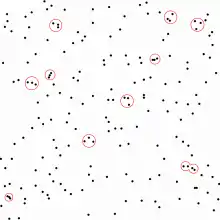Poisson clumping
Poisson clumping, or Poisson bursts,[1] is the phenomenon wherein random events may appear to have a tendency to occur in clusters, clumps, or bursts.

Etymology
Poisson clumping is named for the 19th-century French mathematician Siméon Denis Poisson,[1] who is known for his work on definite integrals, electromagnetic theory, and probability theory and is the namesake of the Poisson distribution.
History
The Poisson process provides a description of random independent events occurring with uniform probability through time or space (or both). The expected number λ of events in a time interval or area of a given measure is proportional to that measure; the distribution of the number of events follows a Poisson distribution entirely determined by the parameter λ. If λ is small, events are rare, but purely by chance they may, nevertheless, occasionally occur in clusters, also referred to as Poisson clumps or Poisson bursts.[2]
Applications
Poisson clumping is used to explain marked increases or decreases in the frequency of an event, such as shark attacks, "coincidences", birthdays, or heads or tails from coin tosses, and e-mail correspondence.[3][4]
Poisson clumping heuristic
Poisson clumping heuristic (PCH), published by David Aldous in 1989,[5] is a model for finding first-order approximations over different areas in a large class of stationary probability models that have a specific monotonicity property for large exclusions. The probability that such a process will achieve a large value is asymptotically small and is distributed in a Poisson fashion.[6]
See also
References
- Yang, Jennifer (30 January 2010). "Numbers don't always tell the whole story". Toronto Star.
- "Shark Attacks May Be a "Poisson Burst"". Science Daily. 23 August 2011.
- Schmuland, Byron. "Shark attacks and the Poisson approximation" (PDF).
- Anteneodo, C.; Malmgren, R. D.; Chialvo, D. R. (2010.) "Poissonian bursts in e-mail correspondence", The European Physical Journal B, 75(3):389–94.
- Aldous, D. (1989.) "Probability Approximations via the Poisson Clumping Heuristic", Applied Mathematical Sciences, 7, Springer
- Sethares, W. A. and Bucklew, J. A. (1991.) Exclusions of Adaptive Algorithms via the Poisson Clumping Heuristic, University of Wisconsin.